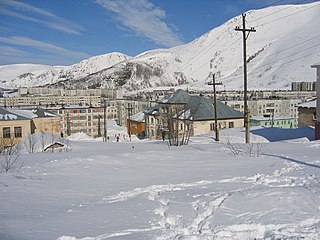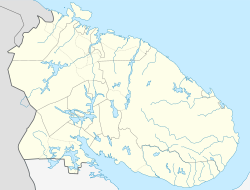
Polyarny is a town and the administrative center of the closed administrative-territorial formation of Alexandrovsk in Murmansk Oblast, Russia, situated on the outermost western side of the Kola Bay. Population: 17,293 (2010 Census); 18,552 (2002 Census); 27,635 (1989 Soviet census).

Zapolyarny is a town in Pechengsky District of Murmansk Oblast, Russia, located on the Kola Peninsula, 10 kilometers (6.2 mi) northeast of the Kola Superdeep Borehole project. Population: 15,825 (2010 Census); 18,640 (2002 Census); 23,564 (1989 Soviet census).

Snezhnogorsk is a town under the administrative jurisdiction of the closed administrative-territorial formation of Alexandrovsk in Murmansk Oblast, Russia. Population: 9,942 (2021 Census); 12,689 (2010 Census); 12,737 (2002 Census);

Apatity is a town in Murmansk Oblast, Russia, located along the Murman Railway, 23 km (14 mi) west of Kirovsk and 185 km (115 mi) south of Murmansk, the administrative center of the oblast. The town is named after one of its most abundant natural resources in the area, apatite, the raw mineral used in the production of phosphorus mineral fertilizers. Population: 59,672 (2010 Census).

Monchegorsk is a town in Murmansk Oblast, Russia, located on the Kola Peninsula, 145 kilometers (90 mi) south of Murmansk, the administrative center of the oblast. Population: 45,361 (2010 Census); 52,242 ; 68,652.

Gadzhiyevo is a town under the administrative jurisdiction of the closed administrative-territorial formation of Alexandrovsk in Murmansk Oblast, Russia. Population: 11,068 (2010 Census); 12,180 (2002 Census).

Olenegorsk is a town in Murmansk Oblast, Russia, located north of the Arctic Circle, 112 kilometers (70 mi) south of Murmansk. Population: 23,072 (2010 Census); 25,166 ; 35,584 (1989 Soviet census).

Kirovsk, known as Khibinogorsk (Хибиного́рск) until 1934, is a town in Murmansk Oblast, Russia, located at the spurs of the Khibiny Mountains on the shores of the Lake Bolshoy Vudyavr, 175 kilometers (109 mi) south of Murmansk. Population: 28,625 (2010 Census).

Polyarnye Zori is a town in Murmansk Oblast, Russia, located on the Niva River, Lake Imandra, and Lake Pinozero, 224 kilometers (139 mi) south of Murmansk. The nearest settlements to Polyarnye Zory are: Zasheek (3 km), Pinozero (4 km), Nivskiy (8 km) and Afrikanda-1,2. Population : 14,196, 15,096 (2010 Census); 15,910 (2002 Census); 19,428 (1989 Soviet census).

Umba is an urban locality in Tersky District of Murmansk Oblast, Russia, located on the Kola Peninsula at the point where the Umba River flows into the Kandalaksha Gulf. Population: 5,532 (2010 Census); 6,497 (2002 Census); 8,309 (1989 Soviet census).

Kildinstroy is an urban locality in Kolsky District of Murmansk Oblast, Russia, located on the Kola Peninsula on the lower Kola River, 9 kilometers (5.6 mi) south of Murmansk. Population: 2,063 (2010 Census); 2,861 ; 3,731.

Tumanny is an urban locality in Kolsky District of Murmansk Oblast, Russia, located on the Kola Peninsula on the lower Voronya River, 96 kilometers (60 mi) east of Murmansk. Population: 685 (2010 Census); 950 (2002 Census); 1,918 (1989 Soviet census).

Zelenoborsky is an urban locality in Kandalakshsky District of Murmansk Oblast, Russia, located directly west of the Kola Peninsula on the lower Kovda River, 235 kilometers (146 mi) south of Murmansk. Population: 6,560 (2010 Census); 7,640 (2002 Census); 9,643 (1989 Soviet census).

Roslyakovo was an urban locality under the administrative jurisdiction of the closed-administrative territorial formation of Severomorsk in Murmansk Oblast, Russia, located on the Kola Peninsula on the Kola Bay, 6 kilometers (3.7 mi) west of Severomorsk proper. It was abolished, with its territory merged into the city of Murmansk, on January 1, 2015. Population: 8,696 (2010 Census); 9,458 (2002 Census); 11,981 (1989 Soviet census).

Safonovo is an urban locality under the administrative jurisdiction of the closed-administrative territorial formation of Severomorsk in Murmansk Oblast, Russia, located on the Kola Peninsula on the Kola Bay, 3 kilometers (1.9 mi) west of Severomorsk proper. Population: 5,255 (2010 Census); 4,853 (2002 Census); 7,661 (1989 Soviet census).

Kovdorsky District is an administrative district (raion), one of the six in Murmansk Oblast, Russia. It is located to the west of the Kola Peninsula. The area of the district is 4,066 square kilometers (1,570 sq mi). Its administrative center is the town of Kovdor. Population: 21,297 (2010 Census); 24,404 (2002 Census); 36,786 (1989 Soviet census). The population of Kovdor accounts for 88.4% of the district's total population.

Kandalakshsky District is an administrative district, one of the six in Murmansk Oblast, Russia. As a municipal division, it is incorporated as Kandalakshsky Municipal District. It is located in the southwest of the oblast, and borders with Kovdorsky District to the north, Loukhsky District of the Republic of Karelia, and with Finland to the west. The area of the district is 14,400 square kilometers (5,600 sq mi). Its administrative center is the town of Kandalaksha. Population: 49,544 (2010 Census); 60,140 (2002 Census); 78,239 (1989 Soviet census). The population of Kandalaksha accounts for 72.0% of the district's total population.
Oktyabrsky Administrative Okrug is a territorial division of the City of Murmansk in Murmansk Oblast, Russia. Population: 95,569 (2010 Census); 104,831 (2002 Census); 144,431 (1989 Soviet census).

Leninsky Administrative Okrug is an okrug of the City of Murmansk in Murmansk Oblast, Russia. Population: 90,331 (2010 Census); 97,755 (2002 Census); 147,235 (1989 Soviet census).
Pervomaysky Administrative Okrug is a territorial division of the City of Murmansk in Murmansk Oblast, Russia. Population: 121,357 (2010 Census); 133,551 (2002 Census); 176,373 (1989 Soviet census).
























